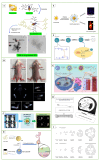Advances in Drug Targeting, Drug Delivery, and Nanotechnology Applications: Therapeutic Significance in Cancer Treatment
- PMID: 39861768
- PMCID: PMC11769154
- DOI: 10.3390/pharmaceutics17010121
Advances in Drug Targeting, Drug Delivery, and Nanotechnology Applications: Therapeutic Significance in Cancer Treatment
Abstract
In the 21st century, thanks to advances in biotechnology and developing pharmaceutical technology, significant progress is being made in effective drug design. Drug targeting aims to ensure that the drug acts only in the pathological area; it is defined as the ability to accumulate selectively and quantitatively in the target tissue or organ, regardless of the chemical structure of the active drug substance and the method of administration. With drug targeting, conventional, biotechnological and gene-derived drugs target the body's organs, tissues, and cells that can be selectively transported to specific regions. These systems serve as drug carriers and regulate the timing of release. Despite having many advantageous features, these systems have limitations in thoroughly treating complex diseases such as cancer. Therefore, combining these systems with nanoparticle technologies is imperative to treat cancer at both local and systemic levels effectively. The nanocarrier-based drug delivery method involves encapsulating target-specific drug molecules into polymeric or vesicular systems. Various drug delivery systems (DDS) were investigated and discussed in this review article. The first part discussed active and passive delivery systems, hydrogels, thermoplastics, microdevices and transdermal-based drug delivery systems. The second part discussed drug carrier systems in nanobiotechnology (carbon nanotubes, nanoparticles, coated, pegylated, solid lipid nanoparticles and smart polymeric nanogels). In the third part, drug targeting advantages were discussed, and finally, market research of commercial drugs used in cancer nanotechnological approaches was included.
Keywords: drug carriers; drug delivery systems; drug targeting; nanotechnology.
Conflict of interest statement
The authors declare no conflict of interest.
Figures





Similar articles
-
Advanced targeted therapies in cancer: Drug nanocarriers, the future of chemotherapy.Eur J Pharm Biopharm. 2015 Jun;93:52-79. doi: 10.1016/j.ejpb.2015.03.018. Epub 2015 Mar 23. Eur J Pharm Biopharm. 2015. PMID: 25813885 Review.
-
Nanobiotechnology-based drug delivery in brain targeting.Curr Pharm Biotechnol. 2013;14(15):1264-74. doi: 10.2174/1389201015666140608143719. Curr Pharm Biotechnol. 2013. PMID: 24910011 Review.
-
Nanosize drug delivery system.Curr Pharm Biotechnol. 2013;14(15):1221. doi: 10.2174/138920101415140804121008. Curr Pharm Biotechnol. 2013. PMID: 25106648
-
New aspects of nanopharmaceutical delivery systems.J Nanosci Nanotechnol. 2008 May;8(5):2216-29. doi: 10.1166/jnn.2008.274. J Nanosci Nanotechnol. 2008. PMID: 18572633 Review.
-
Recent Advances in pH-Sensitive Polymeric Nanoparticles for Smart Drug Delivery in Cancer Therapy.Curr Drug Targets. 2018 Feb 19;19(4):300-317. doi: 10.2174/1389450117666160602202339. Curr Drug Targets. 2018. PMID: 27262486 Review.
Cited by
-
Emerging Applications of Pickering Emulsions in Pharmaceutical Formulations: A Comprehensive Review.Int J Nanomedicine. 2025 May 7;20:5923-5947. doi: 10.2147/IJN.S514928. eCollection 2025. Int J Nanomedicine. 2025. PMID: 40356863 Free PMC article. Review.
-
Exploring hepatic stellate cell-driven fibrosis: therapeutic advances and future perspectives.ADMET DMPK. 2025 Aug 4;13(4):2874. doi: 10.5599/admet.2874. eCollection 2025. ADMET DMPK. 2025. PMID: 40786064 Free PMC article. Review.
-
Nanomedicine in Cancer Therapeutics: Current Perspectives from Bench to Bedside.Mol Cancer. 2025 Jun 9;24(1):169. doi: 10.1186/s12943-025-02368-w. Mol Cancer. 2025. PMID: 40490771 Free PMC article. Review.
-
Preparation, characterization and in vitro evaluation of phosphate-doped bioactive glass nanoparticles as promising candidates for therapeutic applications.BMC Chem. 2025 Jun 19;19(1):170. doi: 10.1186/s13065-025-01543-w. BMC Chem. 2025. PMID: 40537827 Free PMC article.
-
Advances in Photothermal Therapy for Oral Cancer.Int J Mol Sci. 2025 May 2;26(9):4344. doi: 10.3390/ijms26094344. Int J Mol Sci. 2025. PMID: 40362580 Free PMC article. Review.
References
-
- Harish V., Tewari D., Gaur M., Yadav A.B., Swaroop S., Bechelany M., Barhoum A. Review on Nanoparticles and Nanostructured Materials: Bioimaging, Biosensing, Drug Delivery, Tissue Engineering, Antimicrobial, and Agro-Food Applications. Nanomaterials. 2022;12:457. doi: 10.3390/nano12030457. - DOI - PMC - PubMed
-
- Garg J., Pathania K., Sah S.P., Pawar S.V. Nanostructured lipid carriers: A promising drug carrier for targeting brain tumours. Futur. J. Pharm. Sci. 2022;8:25. doi: 10.1186/s43094-022-00414-8. - DOI
-
- Ezegbe C., Umeh O., Ofoefule S. Drug Carriers. J. Curr. Biomed. Res. 2022;2:77–105. doi: 10.54117/jcbr.v2i1.3. - DOI
Publication types
LinkOut - more resources
Full Text Sources

